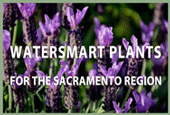This Plant List contains some of the most common very low, low and moderate water-use plants found in the Sacramento region.
This list is intended as a tool to participants in rebate and incentive programs for calculating the living plant coverage requirement (oftentimes a minimum of 50% plant coverage) for the converted area.
Refer to specific requirements for the rebate or incentive program for which you are an applicant to determine if you must use plants only from this list or if you can use plants from this list and plants that are not on this list.
Use of drought-tolerant, low-water-use plants, and California plant species native to this region is highly encouraged.
PLANT COVERAGE & SIZE
Plant Coverage Value
The Plant Coverage Value in square feet is for each plant at its mature width; it is the value that will be used by Program Administrators to determine the canopy coverage regardless of the size of the plant at the time of planting and/or inspection. NOTE: Tree canopy will not be used to determine the 50% plant coverage requirement for Placer County Water Agency's Lawn Replacement Rebate Program.
Coverage value was determined by multiplying the diameter (mature width) of the plant's canopy by .7854. Example: .7854 x 5 ft. diameter x 5 ft. diameter = 20. Totals under .5, were rounded down to the next whole number. Totals above .5, were rounded up to the next whole number.
Where a plant's width is expressed in a range, for example, 20-30' Wide (W), the middle of the width range was used, which in this example is 25' W.
Shrub Sizes
Shrubs have been grouped into the categories of large, medium, and small based on their mature height.
Shrubs - Large 6-15 feet tall at maturity
Shrubs - Medium 4-6 feet tall at maturity
Shrubs - Small 4 feet or less at maturity
Exposure (Sun)
In addition to grouping plants according to their water requirements (hydrozones), plants within each zone need to have the same solar (sun) requirement.
For example: Plants that have low-water-use requirements and prefer full sun should be grouped together and irrigated on the same valve or zone (a valve separate from other zones). Plants with moderate-water-use requirements and prefer part sun should be grouped together and irrigated on a separate valve or zone.
Climate Zone
Based on "The New Sunset Western Garden Book" Climate Zones, which takes into consideration temperature, latitude, elevation, ocean influence, and other factors in determining climate zones. If a Sunset Climate Zone was not available for a plant, the U.S. Department of Agriculture (USDA) Zone, which is based on minimum termperatures, was used and converted to the approximate Sunset Climate Zone.
Uses/Benefits
The letter "Y" in the columns noted as Drought Tolerant, CA Native, Deer Resistant, UC All-Star, Rain Garden, Salt Tolerant/Tolerant of Recycled Water, and/or Fire-Resistant Plants indicates that "Yes" that plant may be appropriate for this use or benefit.
